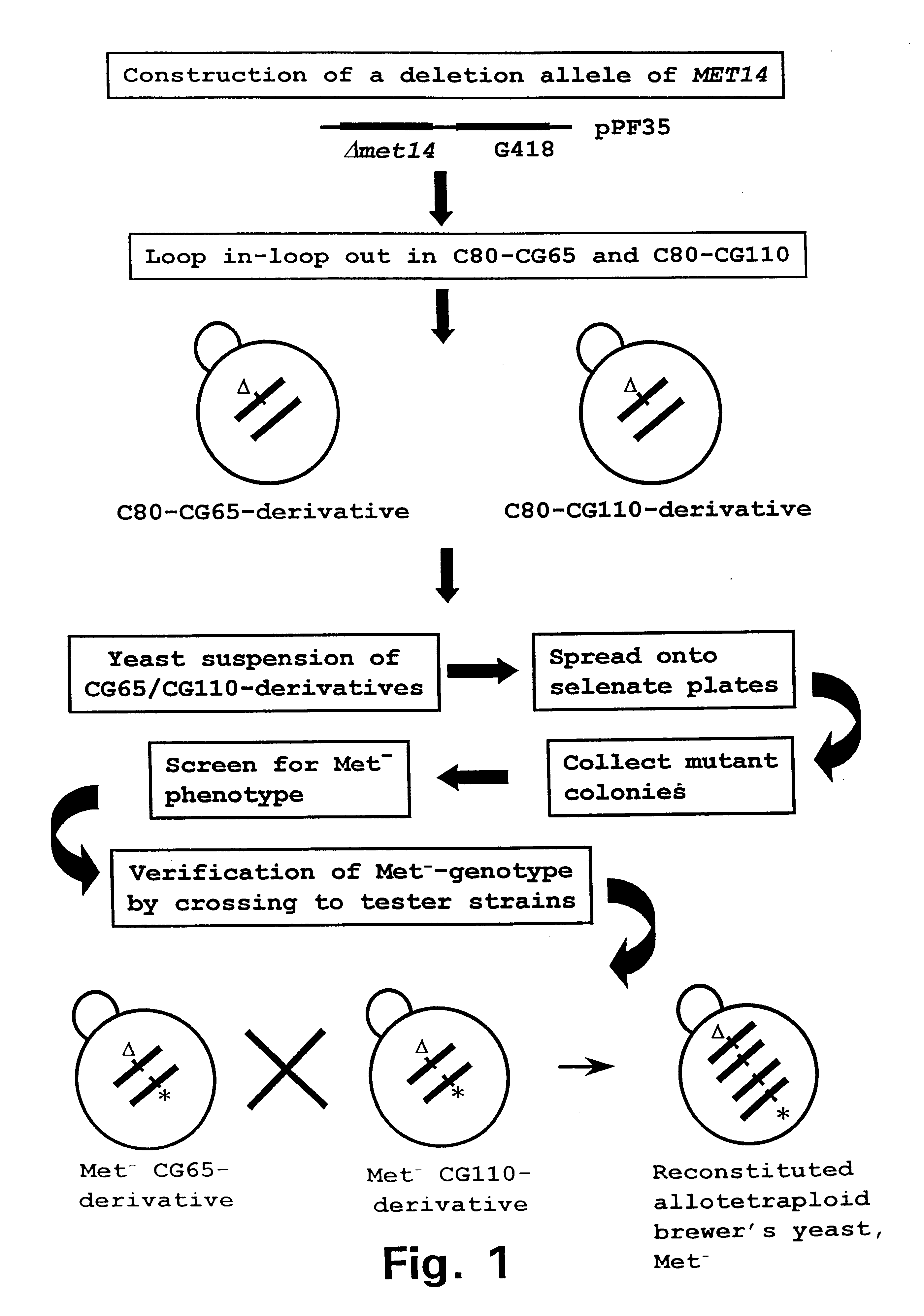Method of producing a composite fermented beverage using genetically modified yeast strains
a technology of genetically modified yeast and composite fermentation, which is applied in the direction of enzymology, fungi based processes, transferases, etc., can solve the problems of spoilage of beer, general undesired taste and flavour, and confer the effect of undesirable taste and flavour
- Summary
- Abstract
- Description
- Claims
- Application Information
AI Technical Summary
Benefits of technology
Problems solved by technology
Method used
Image
Examples
example 1
Construction of S. carisbergensis brewer's yeast without production of sulphite
1.1. Summary of the experiments
Sulphite, being an antioxidant and flavour stabilizer, plays a key role in preservation of beer taste. In order to be able to control the amount of sulphite in a final beer, it was decided to make a brewer's yeast being deficient with respect to sulphite production. By combining beer from low and high sulphite containing beer batches, it would be possible to make beer with a predetermined amount of sulphite. Furthermore, due to a reduced content of the yeast-derived sulphur compounds, the low-sulphite producing yeast strain would be an appropriate basis for construction of a yeast strain which could be used to produce a taste-neutral beer. Such a beer could potentially form the basis for combination with other beer batches.
Saccharomyces carlsbergensis brewer's yeast was inactivated in all four copies of the MET14 gene by disruption combined with classical mutagenesis. Beer p...
example 2
Identification of the genes responsible for reduction of dimethylsulphoxide to dimethyl sulphide and construction of yeast strains inactivated in such genes
2.1. Summary of the experiment
Dimethylsulphide, DMS, is a sulphur compound of importance for the organoleptic properties of beer, especially some lager beers. Production of DMS during beer production occurs partly during wort production and partly during fermentation. Methionine sulphoxide reductases (EC 1.8.4.5 and 1.8.4.6) are enzymes responsible for reduction of oxidized cellular methionines. These enzymes have been suggested to be able to reduce dimethyl sulphoxide (DMSO) as well, with DMS as product.
A gene coding for an enzymatic activity leading to methionine sulphoxide (MetSO) reduction in Saccharomyces yeast has recently been identified.
It was confirmed that the Saccharomyces cerevisiae open reading frame YER042w indeed appears to encode an MetSO reductase, and the name MXR1 is proposed for the gene. An mxr1 disruption mu...
example 3
Construction of mutants of brewer's yeast with altered production of hydrogen sulphide: In vivo evidence for a direct link between formation of H.sub.2 S and certain thiols and thioesters
3.1. Summary of the experiment
Hydrogen sulphide is a brewing yeast-derived sulphur compound of great importance for the taste and flavour of beer. While it provides some of the character of very young beer and may be desired in low amounts to mask the impression of certain other flavour components, it is in general undesired at higher concentrations in beer. Furthermore, certain other taste-active sulphur components, like thiols and thioesters, may be derived from hydrogen sulphide. Here it is shown that it is possible, by classical breeding methods, to construct well-performing brewing yeasts with an altered production of hydrogen sulphide. Furthermore, evidence was found for a direct metabolic link between formation of hydrogen sulphide and of ethanethiol, methylthioester and ethylthioester.
3.2. M...
PUM
| Property | Measurement | Unit |
|---|---|---|
| concentrations | aaaaa | aaaaa |
| volume | aaaaa | aaaaa |
| volume | aaaaa | aaaaa |
Abstract
Description
Claims
Application Information
 Login to View More
Login to View More - R&D
- Intellectual Property
- Life Sciences
- Materials
- Tech Scout
- Unparalleled Data Quality
- Higher Quality Content
- 60% Fewer Hallucinations
Browse by: Latest US Patents, China's latest patents, Technical Efficacy Thesaurus, Application Domain, Technology Topic, Popular Technical Reports.
© 2025 PatSnap. All rights reserved.Legal|Privacy policy|Modern Slavery Act Transparency Statement|Sitemap|About US| Contact US: help@patsnap.com

